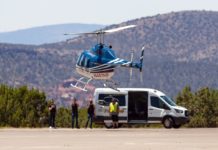Sitting behind his desk of 10 years at the Sedona Airport, Manager Mac McCall flips through a hefty study he just helped finish for the Federal Aviation Administration.
The FAA already has an Airport Certification Manual that dictates the ins and outs of running an airport, he explained. What he and two other consultants were asked to collaborate on was a guidebook for an Airport Safety Management System.
The safety manual looks at what’s happening in airports on a daily basis and makes sure airports are being proactive at preventing emergencies.
In 2010, the FAA will mandate that each air carrier airport incorporate some type of safety management system into the already existing Airport Certification Manual.
Airports will look at McCall’s study and can incorporate a stricter or more lenient safety system, he said. Or, they could incorporate the guide sitting on his desk, as is.
The $300,000 project took two and a half years and 200 pages for McCall, Applied Research Associations and International Safety Research to complete.
The 2010 FAA requirement won’t apply to an airport of Sedona’s size, McCall said, since it doesn’t have any airliners. The biggest plane that lands at Sedona’s “island in the sky” is a Gulf Stream 5, he said.
For 25 years, McCall worked as chief operations supervisor at Chicago’s O’Hare International Airport, dubbed the “busiest airport in the world,” before downsizing to what he calls, “the world’s most scenic.”
In Sedona since 1999, McCall “stumbled” into consulting, he explained, first by voluntarily helping others in his field, and then as an actual business. Now it’s a pretty good part of his business, Mac McCall Airport and Aviation Consulting, he said.
After Sept. 11, 2001, he was hired by the Port Authority of New York & New Jersey for a general management study on the area’s four major airports — John F. Kennedy International, Newark Liberty, LaGuardia and Teterboro. So far, the FAA safety manual was the biggest consulting gig he’s ever had, he said.
McCall’s experiences on the floor of the world’s busiest and one of the snowiest airports lends credibility to his consulting.
With the wind dumping inches of snow at a time on the busy runways, McCall stayed cool, deploying snowplows followed by brooms — or whatever combination it took to keep as many runways open as possible. “I handled 624.8 inches of snow in the course of my career,” he said.
But weather events weren’t the only type of emergency McCall dealt with.
On May 25, 1979, O’Hare experienced the world’s deadliest plane crash, up till that time, which killed 271 people.
Then on July 19, 1989, disaster struck again when an engine exploded during a flight from Denver en route to Chicago and 110 died. McCall and his staff were on the floor at O’Hare to deal with the victims’ families who were waiting at the airport to pick them up.
When snow was falling in Chicago or things were getting hectic, McCall’s friend, the manager of Glendale Municipal Airport, would send him an e-mail. “It’s 80 and sunny,” he’d write.
When the position at the Sedona Airport opened up, McCall applied and after a phone conversation with the airport director, they realized they were on the same page. Two months later, he was behind the desk in Sedona.
Living minutes away from the airport, surrounded by red rock views, every time it snows in Chicago, McCall says he opens a bottle of wine and sits on his terrace.
Alison Ecklund can be reached at 282-7795, ext. 125, or e-mail
aecklund@larsonnewspapers.com





















